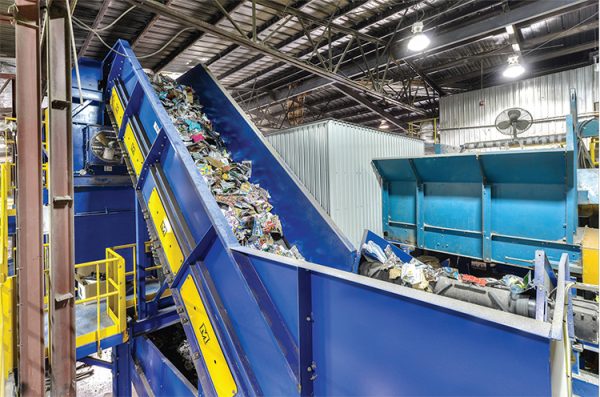
Industry leaders detailed how recycling operations have adapted a year into the pandemic.
During a recent virtual panel, the Northeast Resource Recovery Association reported that many recycling facilities are operating at 100% again, after pandemic disruptions. Additionally, a disease expert offered current guidance on preventing spread in facilities.
NRRA, a nonprofit organization that helps municipalities market their recyclables in the Northeast U.S., held its annual recycling conference as a virtual event last week. During a session titled “Recycling Safely During COVID-19,” two speakers discussed the ongoing impact the pandemic has had on the recycling sector, as well as how far the industry has come in terms of adjusting to pandemic realities.
Bonnie Bethune, member services manager for NRRA, recalled the situation in April 2020, when the impacts of COVID-19 were first hitting many recycling operations.
Some recycling facilities were closed, although most remained open and began operating under new policies to protect staff and residents from the virus, she said. Certain facilities stopped accepting key recyclables, including plastics, OCC, mixed paper and cans, Bethune said.
“Some facilities are still not accepting some of those things,” she said.
Facilities changed traffic patterns, she added. For example, some drop-off facilities allowed one person at a time to deposit recyclables into receptacles. This led to long lines – at a facility in Keene, N.H., for example, there were lines “way out of their facility, all the way down the road,” Bethune said.
Fast forward a year later, in April 2021, and all recycling facilities are back to being operational, many at full operation once again. Many of the COVID-era policies remain in place, including the revised traffic patterns and restricted admittance into buildings.
Many facilities are continuing to require the use of masks and distancing, Bethune added.
The return to normal operations, with certain preventative policies still in place, comes after a year of disruption, but also after a year of more information coming to light about COVID-19. Ben Locwin, an expert on infectious disease epidemiology, gave an update on how knowledge of COVID-19 has evolved since the pandemic first began.
One of those points concerns an early fear for the recycling community: that the virus could be spread via handling recyclables.
Coronaviruses, Locwin noted, “infect us through typically the upper respiratory tract, and so the idea of surface cleaning has been a lot of symbolic theater.”
Instead, Locwin identified the “big four” steps that are more effective in preventing spread. Distancing is first, he said, although he cast aspersions on the common “six feet” rule. He noted viral particles have been demonstrated to be able to spread up to 27 feet from two people sneezing, coughing and talking indoors.
“The whole idea of six feet is really old fashioned dogma and doesn’t really have a lot of basis in physics or reality,” Locwin said.
Still, increasing the distance between people does cut down on the potential for spread, he noted, and it is possible to create enough distance that it’s impossible for viral spread to occur.
“That’s the case for the most part if you’re nowhere near somebody outside, because there’s infinite volumes of fresh air,” Locwin said.
That brings up the second big step in preventing spread: ventilation, which is professionally measured in “air changes per hour.” In any given space, at least six air changes per hour are ideal, Locwin said. That means the air is totally removed and replaced with all different air six times in an hour.
In many indoor spaces there are very few air changes, Locwin said, possibly half or a quarter of the desired six per hour. With lower ventilation indoors comes the third big preventative step, masks, Locwin said. Mask efficacy varies depending on the type of mask being worn, proper mask use and other factors.
Cleaning comes in last in the list of important measures to prevent spread, Locwin said. Surface hygiene is always important, he said, but he added that “for respiratory infections, that’s sort of the last act of prevention.”
As for the three FDA-authorized COVID-19 vaccines, Locwin noted that they have so far been “supremely effective.”
“How the effectiveness and efficacy work is that a vaccinated person has a 95% lower risk of getting COVID-19 compared with a control-group participant who’s not vaccinated,” Locwin said. “So basically the two mRNA vaccines are a couple of the most effective vaccines that we have in the world for anything.”
By comparison, he noted seasonal flu vaccines are often between 40% and 60% effective.
More stories about industry groups
- Industry coalition focuses on small-format material recovery
- EPR stalls out in NY Assembly again
- Q&A: Industry at the ‘ceiling’ of what voluntary action can do